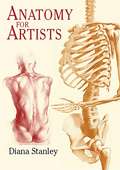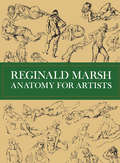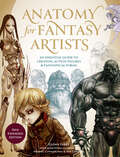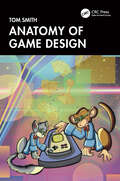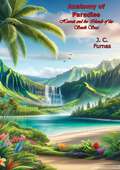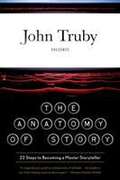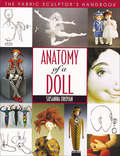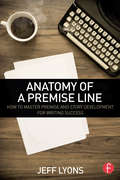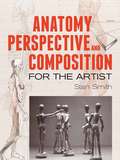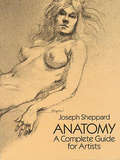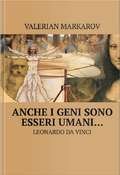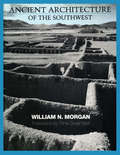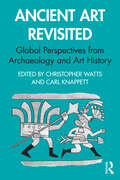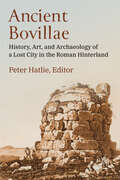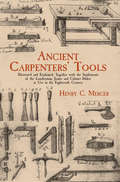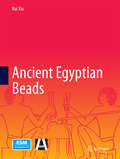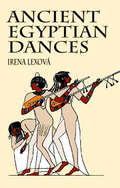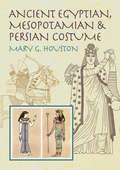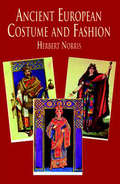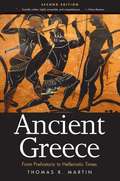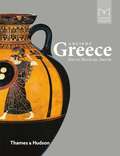- Table View
- List View
Anatomy for Artists
by Diana StanleyConcise and uniquely organized, this outstanding guide teaches the essentials of anatomical rendering. Author Diana Stanley presents numerous illustrations and instructions covering the key aspects of anatomy, without the distractions of unnecessarily extensive technical details that many art students find discouraging. Four major sections constitute the book, with studies of the trunk, the head and neck, the upper limb, and the lower limb. Each section features full coverage of the skeleton, the muscles, and their surface forms. The emphasis throughout is on relating anatomical structure to the actual surface appearance of the body, both at rest and in motion. Sixty-four exceptionally clear and instructive illustrations include diagrams of skeleton and muscle structure, as well as superb examples of figure drawing. This affordably priced and easy-to-reference manual represents an invaluable addition to the library of every artist -- student and professional.
Anatomy for Artists (Dover Anatomy for Artists)
by Reginald MarshPortraying the living human form, not only with anatomical accuracy, but so that it conveys motion, emotion, and vitality is one of the greatest challenges faced by the artist. In the studies in this volume, famous artist and art instructor Reginald Marsh brought his genius to bear on the complex problem of life drawing. Delving into the work of the great masters (Michelangelo, Leonardo, Raphael, Rubens, Poussin, Dürer, Holbein, and others), Marsh simplified, abstracted, adapted, and reinterpreted their work into a collection of drawings both immensely interesting and instructive to the practicing artist and the student. The 209 pages of drawings in this volume show the human body in a wide variety of positions, viewed from many different angles. Marsh directs special attention to those angles, aspects, and physical positions which are the most difficult to portray. His great talent, coupled with a rare ability to instruct others (Marsh taught at the Art Students League for many years) gave him unusual sensitivity to the concerns of the artist in life drawing: his concise commentary on the drawing points up the problems addressed in each -- tone, movement, proportion, composition, etc. The front, side, back, head, arms and hands, legs and feet, and full figure drawings are all included. A separate section on the problems of proportion explores 7, 7 1/2, and 8 head schemes, providing an unusually workable and lucid treatment of the topic for the practicing artist. The body and parts of the body are drawn in skeleton, tissue and muscle, major bone structure, and as they appear in life. Marsh studied medical anatomy as well as the work of the great medical artists in order to perfect his knowledge of human anatomy. All of the hundreds of drawings, figures, and details of this volume have been excellently reproduced in this edition. The last 95 drawings in the book are all original studies by Marsh, never before published in book form. These casual, light-hearted drawings (mostly of female nudes) illustrate both Marsh's seemingly easy mastery of the techniques of life drawing, and his characteristic lusty, Rubenesque style. Because they are so distinctly in his own style, these drawings highlight the great scope and knowledgeability he has shown in the earlier instructive studies. Those who know and admire Marsh as an artist, as well as anyone who wishes to learn to draw from life, will find this volume indispensable.
Anatomy for Fantasy Artists: An Essential Guide to Creating Action Figures & Fantastical Forms
by Glenn FabryAn indispensable guide for anyone interested in improving and developing their fantasy art figures. Start with the basics of human anatomical drawing and musculature, and then learn ways to distort, develop, and transform the human figure, giving it features that range from monstrous or magical to super-agile or larger than life.
Anatomy of Game Design
by Tom SmithPeople have played games forever, but it’s only in the past few decades that people really started thinking about what games are, how they work, and how to make them better.Anatomy of Game Design takes some of the most popular and beloved games of all time and dissects them to see what makes them tick. By breaking down the systems and content of each game, the underlying systems of game design are laid bare.Eight games are analyzed – including Settlers of Catan; Centipede; Candy Crush Saga; Papers, Please; Magic: The Gathering; and more – each representing a different genre or era of game design. Each game is discussed in detail, using the same methods for each game. What are the verbs of the game that give the player agency? How do those verbs fit together to form a core loop that makes the game engaging? What are the systems that power the gameplay? What is the larger flow that makes the game interesting over and over again?Each game is then used as an example to tie back to one or more larger topics in game design, such as systems design, randomness, monetization, game theory, and iterative approaches to game development.Key Features: Uses well-known games to provide specific, discrete examples of broader game design theory Discusses eight popular games using the same methodology to allow comparison of different types of games Includes both high-level theory and academic perspective and practical, real-world guidance from a working game designer who has created these games for commercial release Provides clear direction for deeper inquiry into game design or related fields such as psychology, anthropology, game development, or systems thinking
Anatomy of Paradise Hawaii and the Islands of the South Seas
by J. C. FurnasEmbark on an enchanting journey through the idyllic islands of the Pacific with J. C. Furnas's Anatomy of Paradise: Hawaii and the Islands of the South Seas. This captivating travel narrative offers a rich and detailed exploration of the cultures, landscapes, and histories of Hawaii and the South Sea Islands, capturing the essence of these paradisiacal destinations.Furnas, a skilled writer and keen observer, provides readers with a comprehensive account of his travels through some of the world's most breathtaking and remote locales. From the volcanic majesty of Hawaii to the serene beauty of Tahiti and Fiji, Anatomy of Paradise vividly portrays the natural splendor and unique cultural heritage of each island.The book delves into the complex history of the Pacific Islands, tracing their journey from ancient Polynesian navigators to encounters with European explorers and the impact of colonialism. Anatomy of Paradise is not just a travelogue; it is an exploration of the human spirit and its connection to these enchanting lands. Furnas highlights the resilience, traditions, and daily lives of the islanders, providing a respectful and empathetic portrayal of their societies. His engaging prose brings to life the rhythms of island life, from traditional ceremonies and dances to the challenges of modernity.This book is an essential read for travel enthusiasts, historians, and anyone fascinated by the Pacific Islands. Furnas's evocative storytelling and thorough research create a vivid tapestry of the islands, making Anatomy of Paradise a timeless tribute to one of the world's most captivating regions.Join J. C. Furnas on this unforgettable journey and experience the magic, mystery, and beauty of Hawaii and the Islands of the South Seas through the eyes of a masterful storyteller.
Anatomy of Story: 22 Steps to Becoming a Master Storyteller
by John TrubyJohn Truby is one of the most respected and sought-after story consultants in the film industry, and his students have gone on to pen some of Hollywood's most successful films, including Sleepless in Seattle, Scream, and Shrek. The Anatomy of Story is his long-awaited first book, and it shares all his secrets for writing a compelling script. Based on the lessons in his award-winning class, Great Screenwriting, The Anatomy of Story draws on a broad range of philosophy and mythology, offering fresh techniques and insightful anecdotes alongside Truby's own unique approach to building an effective, multifaceted narrative.
Anatomy of a Doll: The Fabric Sculptor's Handbook
by Susanna Oroyan&“At last! A complete book on doll design and soft sculpture has been written.&” —Virginia Robertson, designer and publisher Master dollmaker Susanna Oroyan gives you the definitive book on fabric sculpting. Anatomy of a Doll is packed with an abundance of exquisite photographs that capture the best work from dollmakers today. Detailed step-by-step illustrations for an incredible variety of cloth dolls are included for you to create any type of cloth doll imaginable. Many methods of doll construction are covered so that beginning and professional dollmakers have a handy answer book. Beginners will find the book a practical guide that examines techniques for making all kinds of dolls. The more experienced dollmaker will discover an abundance of new ideas and techniques never before found in one book. Anatomy of a Doll shows you everything from bending wire to cutting cloth, which will allow you to create your own original dolls!&“[Enjoy] this book as a peerless museum guide, as a user&’s manual of the inventive hand and mind, and as a parable of science.&” —Scientific American&“It&’s finally happened—the cloth doll book that says it all! Thank you Susanna—the table is set, the banquet is prepared!&” —Elinor Peace Bailey, author of Storytelling with Dolls&“Here is all the information you need—written in Susie&’s friendly, casual style.&” —Cary Raesner, editor of Doll World
Anatomy of a Park: Essentials of Recreation Area Planning and Design (Third Edition)
by Donald J. MolnarThis book lays bare the essentials of park design. Although it may serve as an overview or refresher for park designers, this book is written primarily for nondesigners such as lay members of park boards, park directors and superintendents, recreation leaders, and anyone directly affected by what a designer proposes for the development of parklands.
Anatomy of a Premise Line: How to Master Premise and Story Development for Writing Success
by Jeff LyonsIf a story is going to fail, it will do so first at the premise level. Anatomy of a Premise Line: How to Master Premise and Story Development for Writing Success is the only book of its kind to identify a seven-step development process that can be repeated and applied to any story idea. This process will save you time, money, and potentially months of wasted writing. So whether you are trying to write a feature screenplay, develop a television pilot, or just trying to figure out your next story move as a writer, this book gives you the tools you need to know which ideas are worth pursuing. In addition to the 7-step premise development tool, Anatomy of a Premise Line also presents a premise and idea testing methodology that can be used to test any developed premise line. Customized exercises and worksheets are included to facilitate knowledge transfer, so that by the end of the book, you will have a fully developed premise line, log line, tagline, and a completed premise-testing checklist. Here is some of what you will learn inside: Ways to determine whether or not your story is a good fit for print or screen Case studies and hands-on worksheets to help you learn by participating in the process Tips on how to effectively work through writer’s block A companion website (www.routledge.com/cw/lyons) with additional worksheets, videos, and interactive tools to help you learn the basics of perfecting a killer premise line
Anatomy, Perspective and Composition for the Artist (Dover Art Instruction)
by Stan SmithSplendid color illustrations by a distinguished painter and teacher highlight this volume of practical instruction in the foundations of art. Perfect for intermediate-level and advanced artists wishing to take their work to the next level, this manual combines detailed anatomy studies with guidance in the principles and practice of perspective and the art of composition.Author Stan Smith interprets the traditions of European art from the Renaissance onward, providing step-by-step diagrams that develop students' understanding and familiarity with concepts and techniques. Technical and expressive qualities receive equal emphasis. In addition to its value as a source of instruction, this book also functions as an essential reference.
Anatomy: A Complete Guide for Artists (Dover Anatomy for Artists)
by Joseph SheppardIn this superb guidebook, a skilled practitioner of figure drawing demonstrates how to achieve mastery of anatomy through careful, knowledgeable articulation of the muscles and bones lying beneath the skin. Joseph Sheppard's concise instructions have been carefully integrated with over 250 halftone illustrations and over 180 line drawings to lead artists one step at a time through the techniques required in rendering human anatomy convincingly.The opening chapter of the book presents the special techniques involved in mastering human proportion.The chapters that follow each deal with a separate part of the body: the arm, hand, leg, foot, torso, head, and neck (with special coverage of facial features and expressions) and the complete figure.Each of these chapters follows a basic format that combines drawings of the featured body portion from many different angles, coverage of the specific bones and muscles involved, a table of muscle origins and insertions, and coverage of surface anatomy and depictions of the body part in a variety of positions. Joseph Sheppard taught drawing, anatomy, and painting for many years at the Maryland Institute of Art. He is the author of several books of art instruction, and the recipient of a number of distinguished prizes and awards for his sculptures and other works of art, many of which are in the collections of art museums across America.
Anche i geni sono esseri umani: Leonardo da Vinci
by Valerian MarkarovVisse un uomo straordinario, il cui nome è noto ad ognuno: Leonardo d Vinci. La sua vita fu piena di misteri, vittorie e sconfitte, tragedie e amore. Questo appassionante romanzo, basato su avvenimenti storici, ci trasporta nell'Italia dell'epoca del Rinascimento e i suoi personaggi — papi e cardinali, re e condottieri, politici e artisti — sono presenti come persone vive. Nel libro sono toccati temi che possono ferire i sentimenti di una determinata parte di persone. Leggete la stupefacente storia della vita di un uomo bellissimo, una vita divenuta leggenda…
Ancient Architecture of the Southwest
by William N. Morgan<p>During more than a thousand years before Europeans arrived in 1540, the native peoples of what is now the southwestern United States and northern Mexico developed an architecture of rich diversity and beauty. Vestiges of thousands of these dwellings and villages still remain, in locations ranging from Colorado in the north to Chihuahua in the south and from Nevada in the west to eastern New Mexico—a geographical area of some 300,000 square miles. This study presents a comprehensive architectural survey of the region. Professionally rendered drawings comparatively analyze 132 sites by means of standardized 100-foot grids with uniform orientations. Reconstructed plans with shadows representing vertical heights suggest the original appearances of many structures that are now in ruins or no longer exist, while concise texts place them in context.<p> <p>Organized in five chronological sections that include 132 professionally rendered site drawings, the book examines architectural evolution from humble pit houses to sophisticated, multistory pueblos. The sections explore concurrent Mogollon, Hohokam, and Anasazi developments, as well as those in the Salado, Sinagua, Virgin River, Kayenta, and other areas, and compare their architecture to contemporary developments in parts of eastern North America and Mesoamerica. The book concludes with a discussion of changes in Native American architecture in response to European influences. Written for a general audience, the book holds appeal for all students of native Southwestern cultures, as well as for everyone interested in origins in architecture. In particular, it should encourage younger Native American architects to value their rich cultural heritage and to respond as creatively to the challenges of the future as their ancestors did to those of the past.<p>
Ancient Architecture of the Southwest
by William N. MorganDuring more than a thousand years before Europeans arrived in 1540, the native peoples of what is now the southwestern United States and northern Mexico developed an architecture of rich diversity and beauty. Vestiges of thousands of these dwellings and villages still remain, in locations ranging from Colorado in the north to Chihuahua in the south and from Nevada in the west to eastern New Mexico--a geographical area of some 300,000 square miles. This study presents a comprehensive architectural survey of the region. Professionally rendered drawings comparatively analyze 132 sites by means of standardized 100-foot grids with uniform orientations. Reconstructed plans with shadows representing vertical heights suggest the original appearances of many structures that are now in ruins or no longer exist, while concise texts place them in context. Organized in five chronological sections that include 132 professionally rendered site drawings, the book examines architectural evolution from humble pit houses to sophisticated, multistory pueblos. The sections explore concurrent Mogollon, Hohokam, and Anasazi developments, as well as those in the Salado, Sinagua, Virgin River, Kayenta, and other areas, and compare their architecture to contemporary developments in parts of eastern North America and Mesoamerica. The book concludes with a discussion of changes in Native American architecture in response to European influences. Written for a general audience, the book holds appeal for all students of native Southwestern cultures, as well as for everyone interested in origins in architecture. In particular, it should encourage younger Native American architects to value their rich cultural heritage and to respond as creatively to the challenges of the future as their ancestors did to those of the past. During more than a thousand years before Europeans arrived in 1540, the native peoples of what is now the southwestern United States and northern Mexico developed an architecture of rich diversity and beauty. Vestiges of thousands of these dwellings and villages still remain, in locations ranging from Colorado in the north to Chihuahua in the south and from Nevada in the west to eastern New Mexico. This study presents the most comprehensive architectural survey of the region currently available. Organized in five chronological sections that include 132 professionally rendered site drawings, the book examines architectural evolution from humble pit houses to sophisticated, multistory pueblos. The sections explore concurrent Mogollon, Hohokam, and Anasazi developments, as well as those in the Salado, Sinagua, Virgin River, Kayenta, and other areas, and compare their architecture to contemporary developments in parts of eastern North America and Mesoamerica. The book concludes with a discussion of changes in Native American architecture in response to European influences.
Ancient Art Revisited: Global Perspectives from Archaeology and Art History
by Carl Knappett Christopher WattsAncient Art Revisited develops new perspectives on ancient art by weaving together diverse strands within archaeology and art history, exploring it through recent developments in archaeological theory. In order to foster dialogue among various subfields, contributors are drawn from a wide range of domains. Classical archaeology, Aegean prehistory, Near Eastern archaeology, Egyptology, Pre-Columbian South America, and North America are brought together to explore ancient art from multiscalar perspectives and through the lenses of entanglement theory, network thinking, assemblage theory, and other recent theoretical developments. Representing a new wave in research on ancient art, considering both the proximal and distributed operations of artworks, Ancient Art Revisited provides broad and inclusive coverage of ancient art and offers a cohesive approach to a fragmented area of study. This book will be suitable for archaeologists, anthropologists, and art historians wishing to understand the latest thinking on ancient art.
Ancient Bovillae: History, Art, and Archaeology of a Lost City in the Roman Hinterland
by UnknownAncient Bovillae is the first comprehensive study in English about the ancient city south of Rome that flourished for centuries before eventual abandonment. After its peak of prosperity and influence in the first and second centuries CE, Bovillae went into steady decline as an urban center, then disappeared as an identifiable physical entity during the Middle Ages, and finally came to suffer complete abandonment in modern times. Despite previous archaeological inquiries, no major study on Bovillae has appeared in any language other than Italian, nor has there been one as comprehensive as this volume's examination. Ancient Bovillae goes well beyond the work of any previous publication by gathering together all known evidence about the city from the ancient, medieval, and modern ages, with contributors analyzing the significance of Bovillae in art, architecture, religion, and history. Written by a distinguished team of scholars and featuring nearly one hundred images of artifacts, monuments, and technical drawings associated with Bovillae, this book boldly pieces together evidence about the history, art, and archaeology of Bovillae. It draws attention to Bovillae’s significance within the Roman world as well as its transformation and decline in the post-Roman era.
Ancient Carpenters' Tools: Illustrated and Explained, Together with the Implements of the Lumberman, Joiner and Cabinet-Maker i
by Henry C. MercerClassic reference describes in detail hundreds of implements in use in the American colonies in the 18th century. Over 250 illustrations depict tools identical in construction to ancient devices once used by the Greeks, Egyptians, and Chinese, among them axes, saws, clamps, chisels, mallets, and much more. An invaluable sourcebook.
Ancient Egyptian Beads
by Nai XiaThis book presents a detailed analysis and thorough study of the unique collection of Ancient Egyptian beads in the Petrie Museum of Egyptian Archaeology in London. The book first discusses the archaeological value of beads and the method employed in the study of them, especially emphasizing the importance of the technique of bead-making for dating purposes. It then examines and evaluates various schemes for the classification of beads. The book goes on to propose a new classification system and works out a comprehensive corpus of beads with the aid of sixteen plates. Next, the book features a chronological survey that details the material, typology (including the technical peculiarities), use, arrangement and pictorial representation of beads throughout the nine divisions or periods of Ancient Egyptian history. This survey points out the characteristics of each period as well any contact Egypt may have experienced with foreign countries as shown by the beads. It also corrects much wrong identifications of materials and mistaken datings. This book is based on the Ph. D dissertation written by pioneering Chinese archaeologist Xia Nai when he studied in London College University some 70 years ago and who had direct access to considerable firsthand resources at the forefront of Egyptology research. It represents a crucial and long-awaited advance in archaeology, not only for Egypt but for the study of the past across Africa and beyond.
Ancient Egyptian Dances
by Irena LexováDancing was important to the ancient Egyptians. One of the few books available in English on this topic, this carefully researched, profusely illustrated work investigates the origins, nature and role of dance in Egyptian culture. Features 80 figure drawings and illustrations adapted from tomb paintings, reliefs, other authentic sources. New introduction. Bibliography.
Ancient Egyptian, Mesopotamian & Persian Costume
by Mary G. HoustonClothing was hardly a practical necessity in North Africa and what is today the Middle East. Often a luxury item in these warm, humid climates, it became more essential as people's lives improved socially and economically. But even then, the drapery was light and tended to accent the body's shape rather than conceal it. The first part of this profusely illustrated and scrupulously researched text examines the evolution in apparel worn by Egyptian royalty, priests, musicians, manual workers, the military, and foreigners (as depicted by Egyptian artists). Two additional sections consider clothing worn in ancient Mesopotamia and Persia, focusing largely on Sumerian, Babylonian, and Assyrian styles. Over 250 illustrations, drawn in the artistic style of the period, are accompanied by flat patterns showing the cut of the garment, thus enabling today's costumers to accurately reconstruct this apparel. A comprehensive archive that will not only be of immense value to fashion historians and students of costume design, this volume will also fascinate anyone interested in the development of artistic representation.
Ancient European Costume and Fashion
by Herbert NorrisScrupulously researched book by noted authority traces the development of European clothing styles from prehistory to the Norman Conquest in A.D. 1066. Over 160 illustrations, including 17 full-color plates, display draped robes of classical Greece, the jewel-encrusted apparel of a 10th-century Byzantine emperor, garments of peasants, as well as footwear, hairstyles, headdresses, and jewelry.
Ancient Glass
by Julian HendersonThis book is an interdisciplinary exploration of archaeological glass in which technological, historical, geological, chemical and cultural aspects of the study of ancient glass are combined. The book examines why and how this unique material was invented some 4,500 years ago and considers the ritual, social, economic and political contexts of its development. It also provides an in-depth consideration of glass as a material, the raw materials used to make it, and its wide range of chemical compositions in both the East and the West from its invention to the seventeenth century AD. Julian Henderson focuses on three contrasting archaeological and scientific case studies: Late Bronze Age glass, late Hellenistic–early Roman glass, and Islamic glass in the Middle East. He considers in detail the provenances of ancient glass using scientific techniques and discusses a range of vessels and their uses in ancient societies.
Ancient Greece
by Robert PayneA history of Greece from its founding to the advent of Philip of Macedon. Covers all aspects of Greek life, philosophy and literature.
Ancient Greece
by Thomas MartinIn this compact yet comprehensive history of ancient Greece, Thomas R. Martin brings alive Greek civilization from its Stone Age roots to the fourth century B.C. Focusing on the development of the Greek city-state and the society, culture, and architecture of Athens in its Golden Age, Martin integrates political, military, social, and cultural history in a book that will appeal to students and general readers alike. Now in its second edition, this classic work now features new maps and illustrations, a new introduction, and updates throughout. â œA limpidly written, highly accessible, and comprehensive history of Greece and its civilizations from prehistory through the collapse of Alexander the Greatâ TMs empire. . . . A highly readable account of ancient Greece, particularly useful as an introductory or review text for the student or the general reader.â ?â "Kirkus Reviews â œA polished and informative work that will be useful for general readers and students.â ?â "Daniel Tompkins, Temple University
Ancient Greece (Pocket Museum)
by David SmithA vast collection of significant works of art from the whole of ancient Greek civilization and a range of museums, gathered in one handy, pocket-sized guide <p><p> The numerous treasures of ancient Greece are scattered all over the world, impossible to view in the context of fellow objects, or in some cases impossible to see at all, without visiting institutions across the globe. This magnificently illustrated book presents more than 200 objects currently housed in public collections around the world that offer both context and immediacy to the rich culture of ancient Greece. From the bifacial hand tools of the Lower Palaeolithic to the Hellenistic Great Altar of Pergamon,the artifacts presented here reveal a complex sociocultural history of shifting priorities, spiritual beliefs, and cultural traditions. Objects from across the Greek world, valued in life and in death, reflect the transmission of shared ideals across vast distances through relationships maintained for centuries at a time. <p> Pocket Museum: Ancient Greece also offers an insight into the history of collecting and methods of interpretation, examining how the perception of objects has changed over time. Beautifully illustrated with photographs of each featured artifact, this is an absorbing introduction to a culture that has exerted an unparalleled influence on Western civilization.
